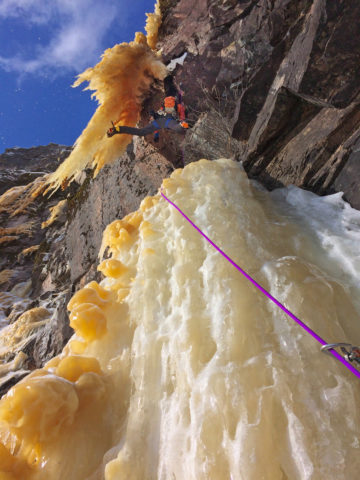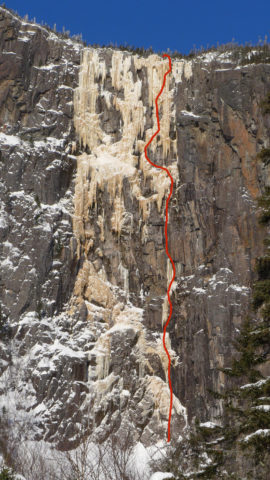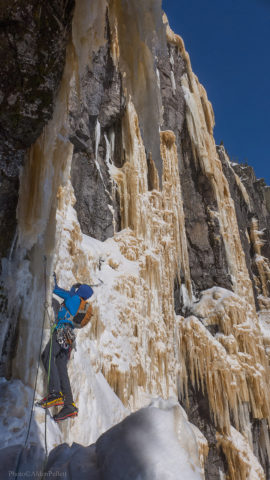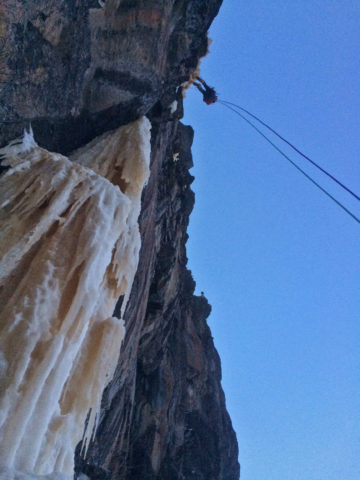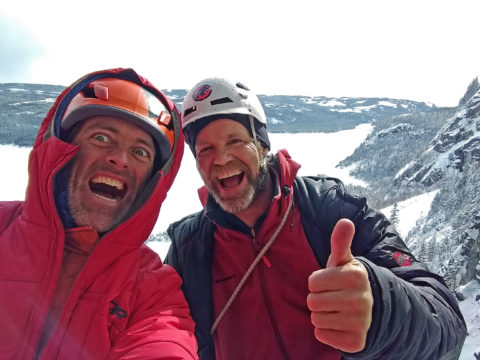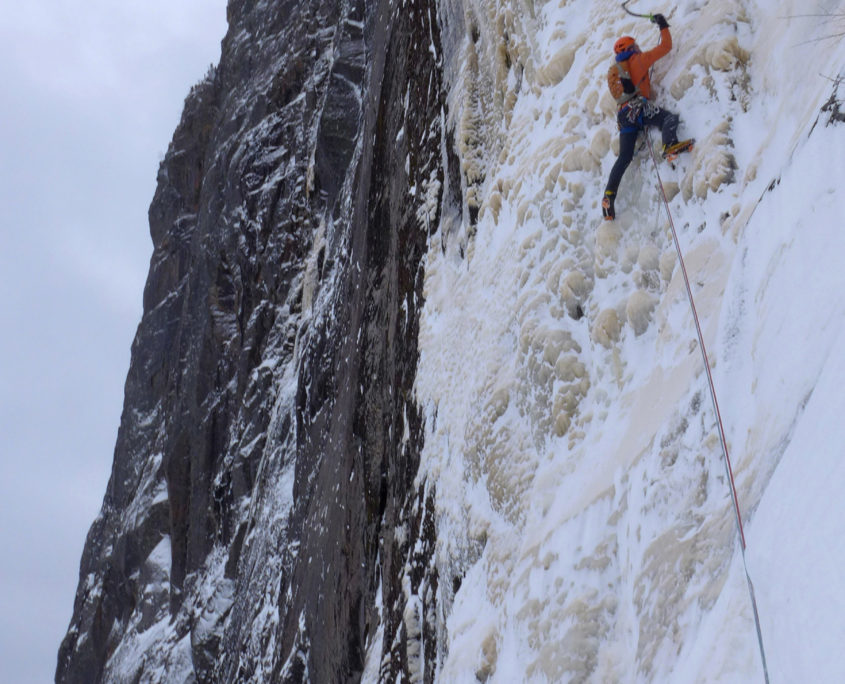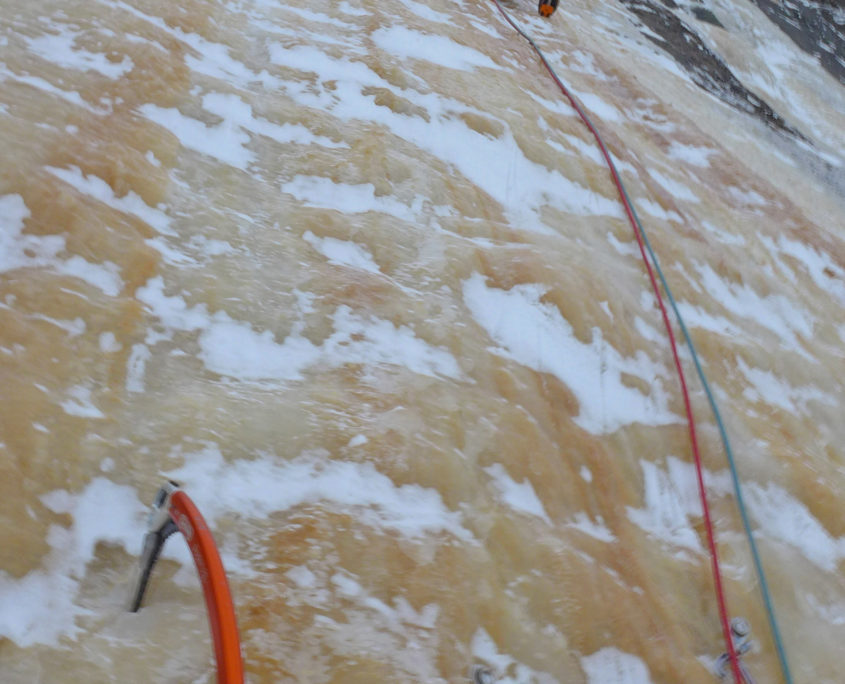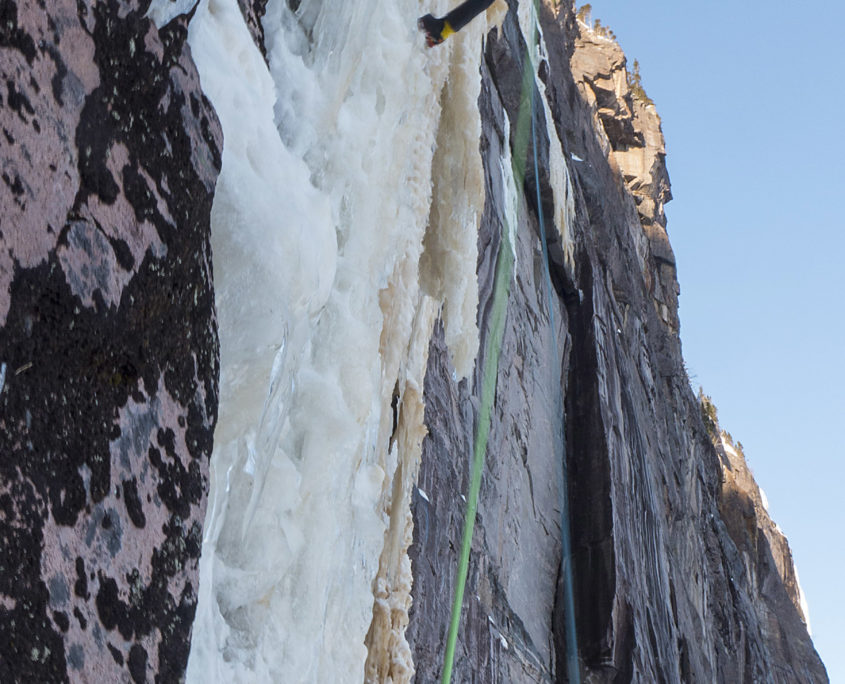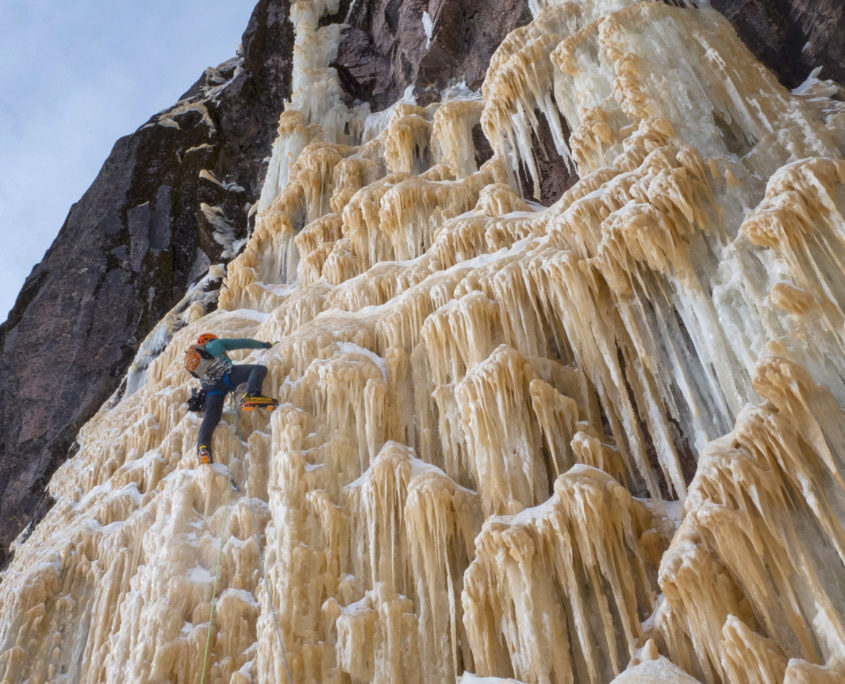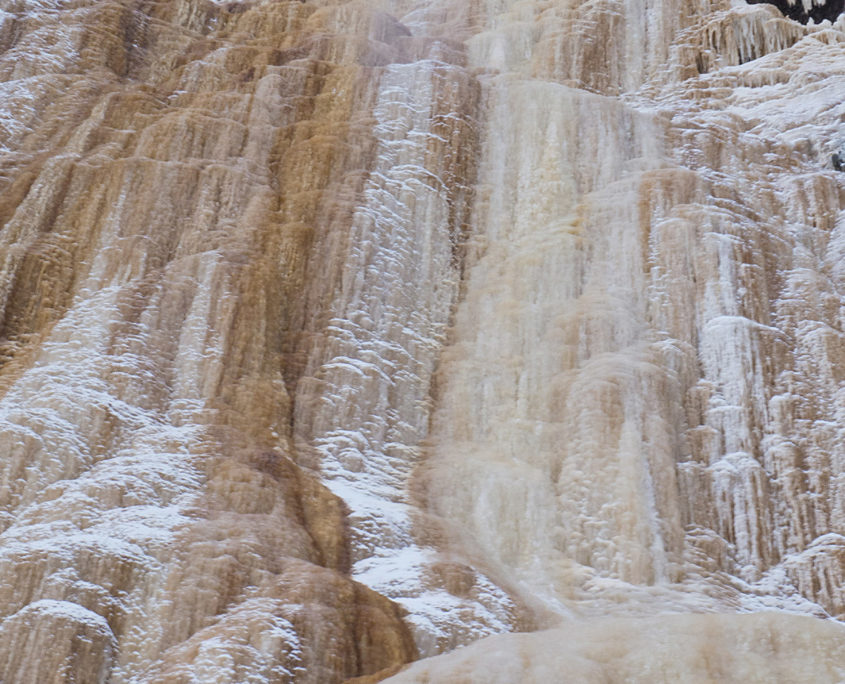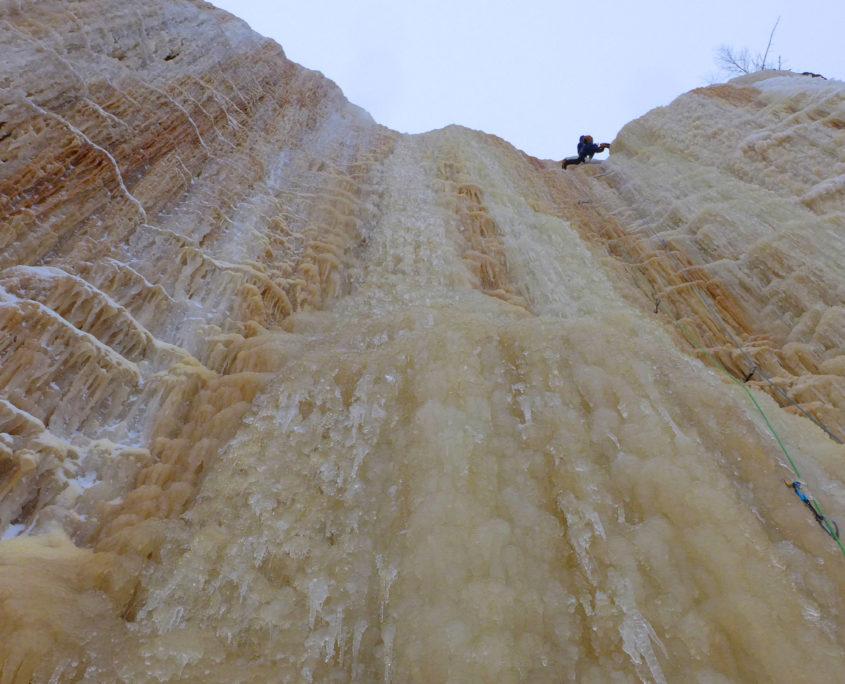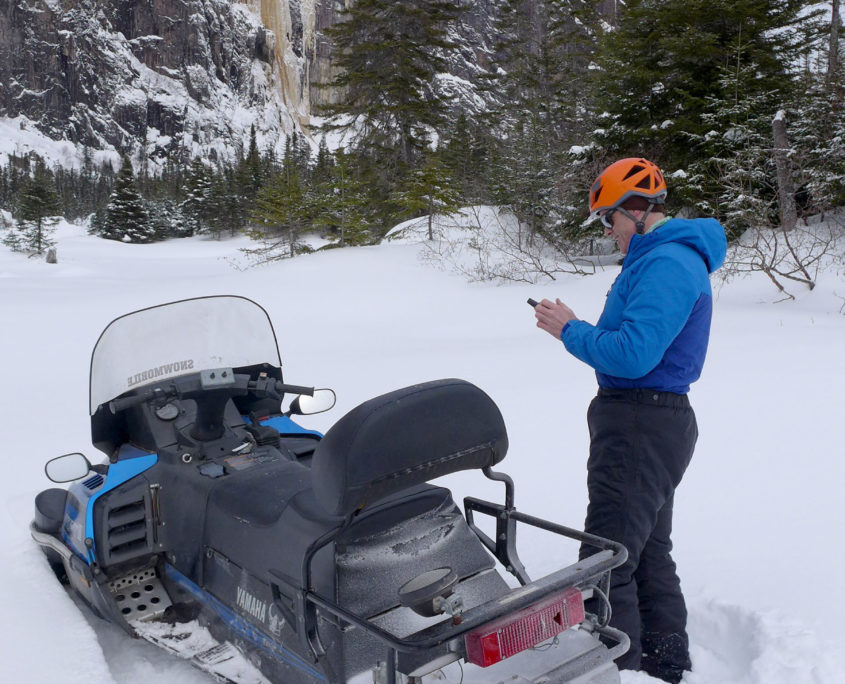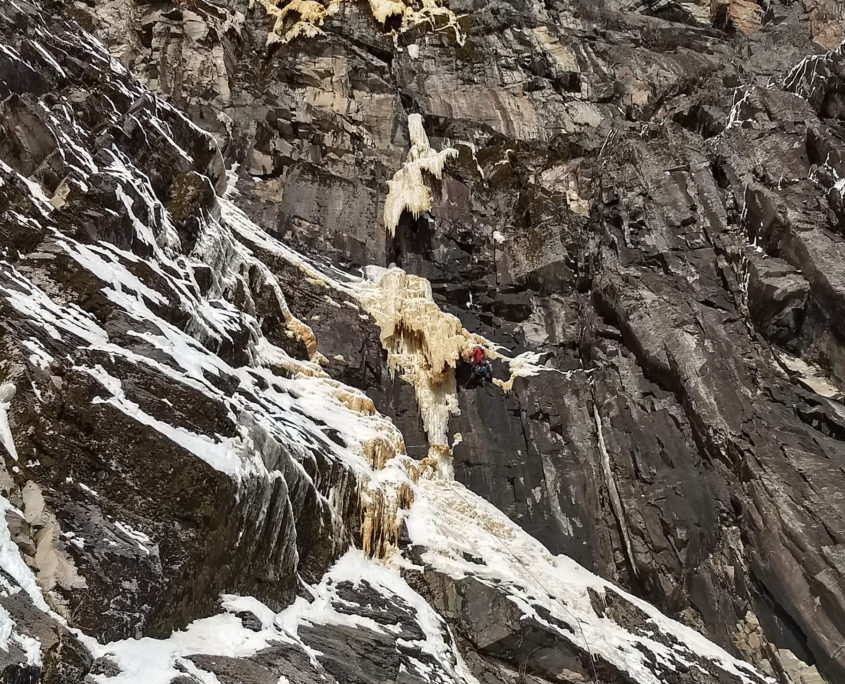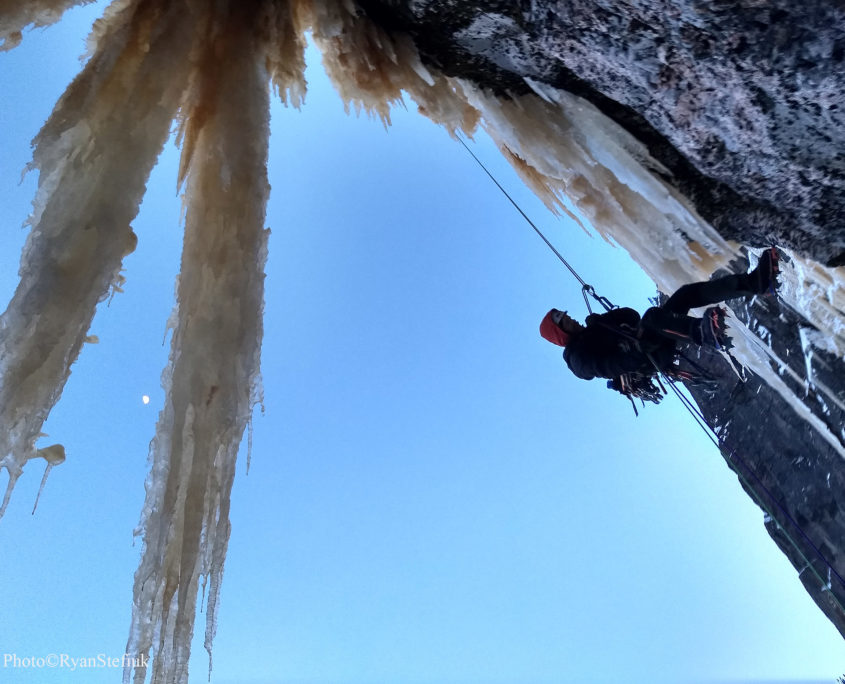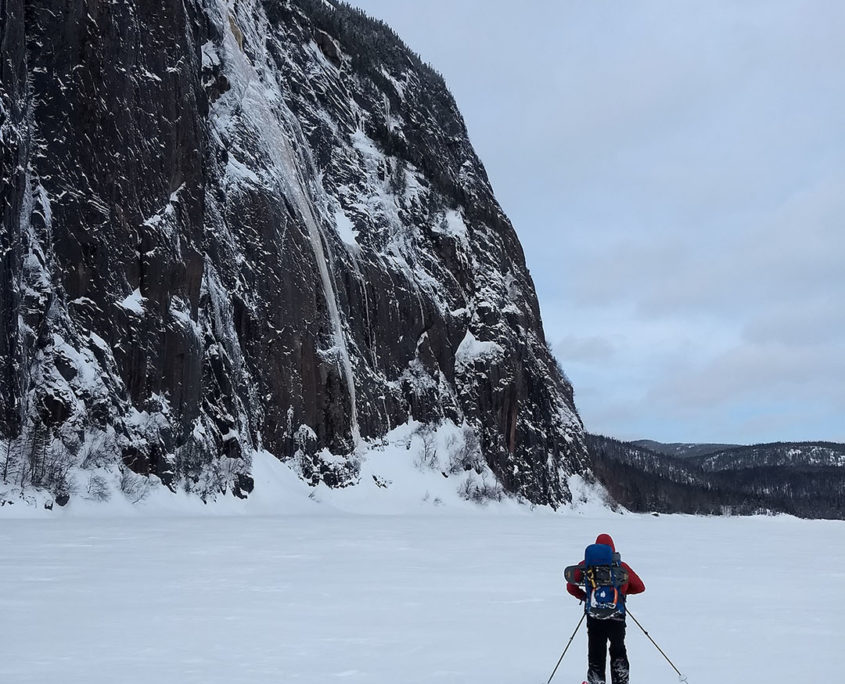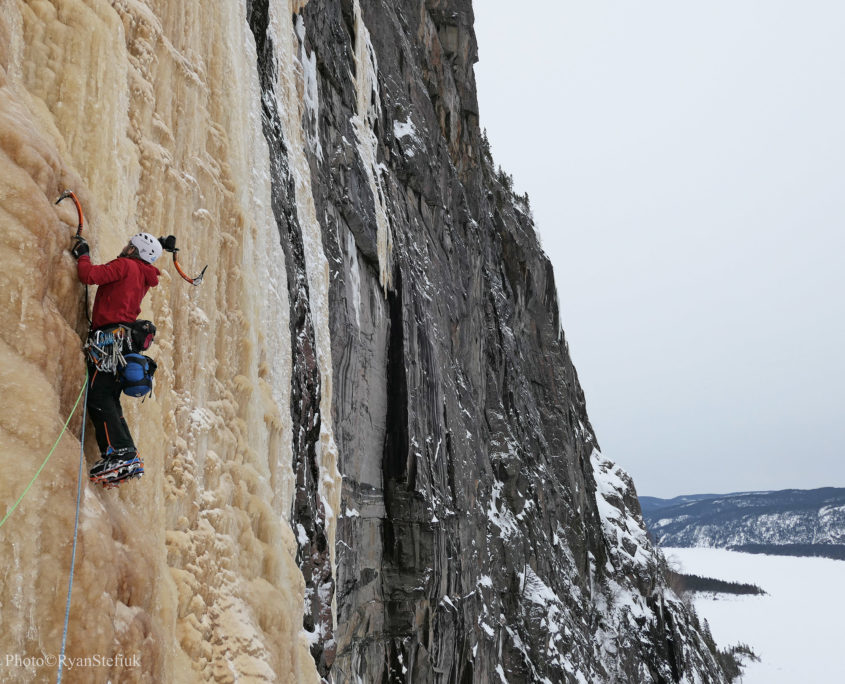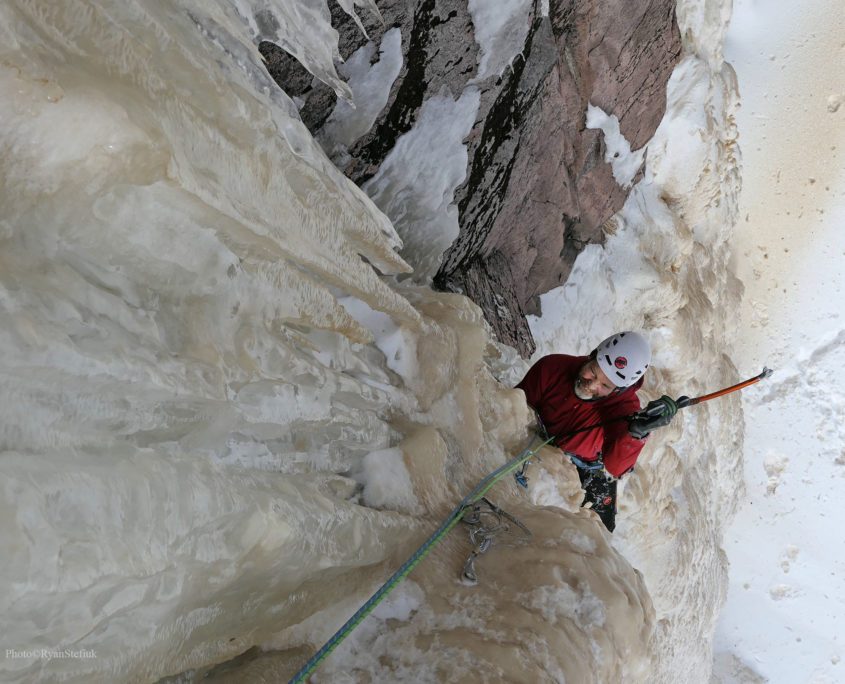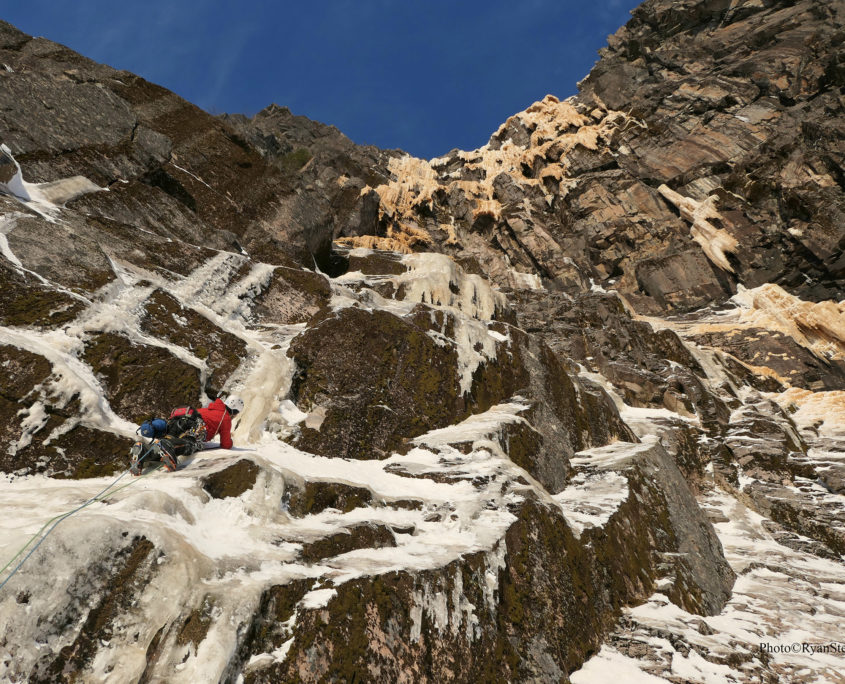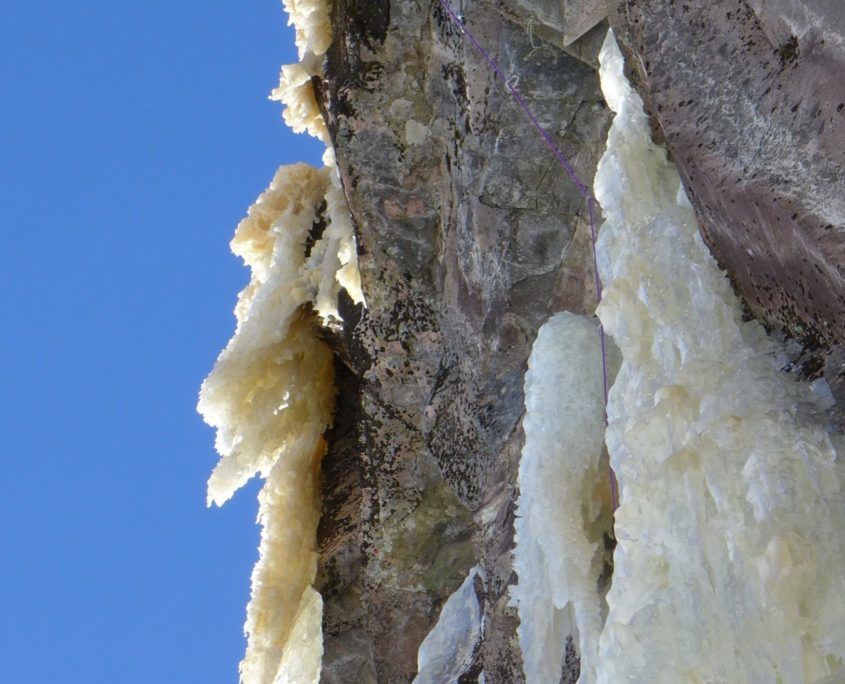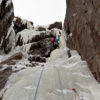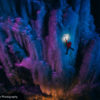Fire on the Cote-Nord
March 23, 2018 / NEice Contributor
Ryan Stefiuk
For more than five minutes my left foot has been pasted in a minuscule slanted divot far left of the crack in front of me. My right foot is below me on a good small edge. My high right tool is in good ice hanging out of the roof above. With my left arm I’m trying to cop a rest, wrapping my entire arm around the tool, placed securely in a good torque crack by my face. A big rest lies just above, where I’ll be able to stem between two small bits of ice.
Ryan Stefiuk stemming out in the M7 overhang on the second pitch of Routes des baleines.
Over the last hour I’ve willed my way upward, moving in low gear, finding good hooks for my ice tools and placing small gear to supplement the spaced-out bolts along the intermittent crack system. All of my cams were frozen and the green Camalot was seized entirely. I’d resorted to blowing on the cam I thought was the proper size until it thawed and then quickly stuffing it in the crack before it refroze. My arms are gassed. I had my first arm cramp near the start of the pitch. Usually, that’s one of my body’s first signals that my muscles are getting tired. Mostly I ignore it, but it will keep happening until it becomes a problem. If my feet cut, it’s over. I won’t be able to hang on. Slowly and carefully, I climb into the rest. From here, I know the remainder of the pitch, a short section of rust-colored WI6 blobs, should be casual compared to the overhanging M9 seam just below my feet.
Half an hour and fifty feet of WI6 later, I’ve got my partner Alden on belay. My hands ache and if I pull too hard on the rope my forearms cramp. There’s only sixty meters to the top. It’s a single pitch of WI7- ice. I don’t even know what “WI7” means, but we are most certainly not going down. We’re not done yet. Alden pokes his head over the lip and a few minutes later we’re together enjoying one of the most spacious belays either of us has experienced on a big ice route.
Routes des baleines, WI7-,M9, follows the mixed line marked in red. Le Mulot climbs the left side of the wall.
Both of us are in disbelief at what just happened. It was positively insane. It’s the last day of our trip and we’re three pitches up this absurdly steep four-pitch wall above the Riviere Sainte-Marguerite, five miles from the road. We’re almost to the top of Routes des Baleines, 190 meters, WI7-, M9, a stunning new hard mixed route established just a few days earlier by a pair of very strong climbers from Toronto, Stas Beskin and Daniel Martian. All day long the collective attitude for us has been “we can go down whenever we want.”
Alden led the first pitch, a forty meter stretch of scrappy WI6 with a huge orange ice roof midway up, beating the sun to the belay. In a matter of minutes each curtain of ice that was above us began to spray like a shower. The wall above was so steep that any bigger bits of falling ice sailed past us, out into space, but the spray was everywhere. I led the second pitch, torquing in nice tool slots up a short section of steep M7 followed by airy stemming out wild flame-colored WI6 curtain. When I reached the first ascent party’s rappel threads above I thought “we can go down whenever we want.” I backed up the thread and kept going to the closet-shaped belay alcove twenty feet further up. The third pitch had been an absolute battle up a continuously overhanging M9 crack system with challenging small footholds. Somehow, I’d managed to onsight the pitch. Now we were in a giant ice cave, gear and ropes strewn on the ground. Only one sixty-meter pitch remained, and together we were pretty sure we’d get to the top.
Right from the start, I was intimidated by the final pitch. Alden and I had climbed Le Mulot earlier in the trip and we knew the final headwall was exactly sixty meters to the trees on top. It’s an amazing, steep wall of ice. We also knew that the right side of the headwall looked rowdy compared to merely vertical Le Mulot on the left. That pitch, which wandered up some seriously steep ice, was going to have significant pucker factor.
Ryan Stefiuk leaves the belay on the 3rd pitch of Le Mulot, WI6. The new mixed route, Routes des baleines, climbs the rightmost steep columns in the background, mixed climbing from below.
We agreed I would lead. I could tapout at any time if needed. Alden could take over. I left the belay and moved up to an ice roof shaped like a giant golden jellyfish, it’s wispy tentacles unwilling to support the weight of my frontpoints. Over this, and I made my way rightward along a ramp onto a huge face. I was tired and the exposure weighed on me. Ice from each tool placement fell cleanly away, hitting nothing as it dropped over 500 feet to the ground. Poking my head around the corner, I saw three choices and quickly ranked them. Above me on the left looked hard and scary. Did I mention that I was tired? I was definitely not going that way. The pillar on the right looked climbable but challenging. Further right? Damn, there was no escape further right. I took the right-hand pillar. The tool placements were airy but the feet were big. The protection felt far away all the time. I placed a screw at face height below the final pumpy bulge and gunned it to a ledge above. I wove my way around a few more blobs and could see the trees. In the last ten feet, with fatigue setting in, I placed my remaining three stubbies in shallow sun-baked ice and crawled into the stunted spruce shrubs on top. The snow instantly made my hands, in thin gloves, really cold. I thrashed over to an ice bulge on the left and built a thread with my one remaining screw.
On top, while belaying Alden, ecstatic about having made the second free ascent of Routes des Baleines, IV WI7-M9-, I choked back a tear or two and marveled at the complexity of the situation. My health has been up and down, with two successive injuries in late fall and the flu in early February. After the second injury I ended up with a blood clot in my calf (DVT) and had to take blood thinners and rest most of December. Alden and I had struggled on our trip together last year. Alden battled a serious cold the entire trip while I wandered around the fjords in western Newfoundland by myself taking pictures. That trip challenged both of us. This winter I’d only really climbed three or four days of ice. On the first day of our trip, standing below Pilier Simon Proulx, I’d wondered if I could keep my head in shape up here with so little ice climbing under my belt this season.
In the end though, things went our way on this day and on the trip as a whole. We tuned up for five days on other huge Cote-Nord classics. Earlier that same week, Stas Beskin and Daniel Martian made the first ascent of Routes des Baleines, clearing out ice in crucial places. “This might be our only chance to climb the route in good shape,” I’d reasoned, trying to help Alden wrap his brain around attempting such a difficult line in the backcountry. The sun, which beats viciously on the Sainte-Marguerite headwall, was partly obscured by clouds and the hilltop to the south during the latter part of the day. The ice remained soft for the rest of the day, but the shower was off and the dripping above slowed to a trickle. The belays were plush and sheltered; big enough to toss gear off without clipping things in. The rappel was already equipped with threads, all we had to do was go down whenever we wanted. Best of all, the snowmobile I bought last month waited on the frozen river below, ready to get us out of the woods at the end of the day. Alden had taken to calling it our “alpine weapon,” as it transformed a two-hour ski into a casual twenty-minute ride.
As is so often the case, there wasn’t really any celebration on top. It was getting dark, the gear was frozen, and both of us were soaked from the brief period of spray earlier in the day. We opted to rappel the route. It was so steep the ropes did not touch the wall at any time on any of the rappels until we hit the slabs below. There is always something creepy about steep rappels on big routes. Darkness makes it worse. I just want to be at the next anchor as fast as possible. Heading down the M9 pitch the rope ends hung fifteen feet out from the wall. Alden had to redirect the rope in through two pieces of gear so he could reach the ledges below. I cleaned the directionals and pulled myself into the wall once I was even with the anchor. Two more rappels and darkness fully set in as we downclimbed the final few feet to our packs.
The ropes hang out in space as Ryan Stefiuk rappels the third pitch crux section after climbing Routes des baleines.
Relieved to be on the ground, the conversation kept circling back to diversity of wild features we had climbed throughout the course of the day. Each of the four pitches had been unique with challenging variety of wild orange-colored overhanging ice features to surmount. The mixed climbing in the middle of the route follows obvious features and is of exceptional quality. There was clean, secure and well-protected drytooling up chimneys, flares, seams and overhangs on bulletproof pink and black granitic gneiss.
Back down on the river it snowed sideways. At this point it was fully dark. The Viking (my snowmobile) was loaded, warmed up, and ready to go. We climbed on and I eased it down the embankment onto the river proper. The right ski dove deeply into a big drift. I really do suck at driving this thing. That’s what you get for being a flatlander. I stood on the left side of the tunnel (the frame on a snowmobile), gave the sled some gas, and it leveled out, no big deal. Driving it in deep snow has gotten easier. Fifteen minutes later we’d made it to the car, celebratory beers in hand, worked, psyched and perhaps a bit sad about leaving such an awe-inspiring place after a great climbing trip.
————————————————————————————————-
I’ve been home a few weeks now, back to working twelve-hour night shifts as a nurse at a local hospital, and the trip feels like a dream. As quickly as I try to share my experiences, I fail. I’ll never be able to share the full wildness of my experience with my coworkers, other climbing partners, or even my own partner. So many of our experiences don’t translate well. I probably wouldn’t do my own experiences justice anyway.
As usual I’m left with lots of questions and a few takeaways. How is it that we climbed so many good hard routes in one trip? There’s always an element of good fortune in a successful ascent, whether it’s cooperative weather or opportune timing. However, we were careful about choosing the right objectives, ramping the difficulty up slowly over six climbing days. Resting for a full day between each route felt like a lot of downtime, but we never went into a climb feeling run down. By the end of the trip we’d climbed five lines on the headwall along the Riviere Sainte-Marguerite. The huge wall of ice and rock had begun to feel smaller, almost crag-like. This allowed us to approach Route des Baleines with a pitch by pitch mentality. We’d climbed plenty of things like this at home, just never stacked with seven hundred feet of features. Will this be a highlight of my life as an ice climber? What a question to ask oneself. I think about this more often than I used to though. Time has a way of slipping past. Injuries happen, and it takes most of us aging climbers longer to heal. Health is a fickle beast that treats each of us differently, and some of us unfairly. I don’t know. For almost twenty years I’ve been plugging away at this winter game. Every year I’ve tried to expand my understanding of ice, mixed and rock climbing. Five years ago I was physically stronger than I am now, and there is no way I would’ve led some of the pitches we climbed on this trip. The real reward is in the process and the partnership, the nitty gritty details along the way, all the things that make climbing bigger, more challenging ascents feel even remotely possible.
The importance of partnership stands out for me on this trip. I’ve been climbing with Alden Pellett for 16 years. We met when I was 22 and relatively new to ice climbing. He helped me become a stronger leader on ice. Since then we’ve shared a rope on countless long routes in Newfoundland. On recent trips, with steeper mixed climbing, I’ve taken the sharp end more often. The mentor-mentee relationship is a two way street, especially when the partnership is a lasting one. Each of us accept’s the other as they are. I’m the nitpicky perfectionist Alden has to put up with, always nervous and hung up on small details. I fall asleep first and I snore. Sometimes I’m thoughtful and broody. Alden invariably cracks jokes and tells me to keep climbing, only half in jest, even though I just told him the last three screws are shit. Occasionally, I have to tell him to stop. Five minutes later he’ll start again. He makes me laugh even when I’m scared shitless. I’ll encourage him not to solo, and remind him that his wife appreciates it when he places lots of gear. He’ll probably talk about the time he got scooped on the first ascent of Solstice at Lake Willoughby on this trip too, at least once. This will also make us laugh. We know each other well. There is depth and comfort in our imperfect yet highly functional friendship.
Ryan Stefiuk, left, and Alden Pellett, right, celebrate at the top, after climbing “Le Mulot”, WI6, in Sept Isles, Quebec.
Anyone who’s taken climbing trips knows that some trips feel productive and successful, and others not so much. Bad trips happen occasionally, and they’re hard to take in stride. Maybe it’s the weather, or the wrong partner, or other things that compound and feel like they explode in your face. Most trips are good, safe with some memorable climbing. They feed the rat. There are great trips too, full of wildness, fear, laughter, and friendship, and they happen rarely. A couple of times maybe, and you know them like they smacked you in the face. This trip to the Cote-Nord was a great one – a giant bundle of memories that I’ll use to keep the flame of adventure burning until my next fire.
Photos from the Trip
by Alden Pellett & Ryan Stefiuk
Our Cote-Nord climbs – February 2018
- Pilier Simon Proulx – WI5, 170m
- Capteur de Reve – WI5+, 220m (probable 4th ascent)
- Speedy Gonzalez – WI6, 170m
- Le Mulot – WI6, 190m
- Speedy Trap – WI6+M7+ (2nd free ascent)
- Routes des Baleines, WI7-M9-, 190m (2nd free ascent)
Information about Routes des Baleines (WI6+M7+) from Rock and Ice can be found here: http://rockandice.com/climbing-news/bold-new-ice-climb-quebec-routes-des-baleines/

